Photo: Chair Aaron Pikcilingis, Community Preservation Committee
It was CPC Night on the third session of Belmont’s annual Town Meeting as six of the eight applications from the Community Preservation Committee were overwhelmingly approved by the members at the meeting held Monday, May 12, at the Belmont High School auditorium. One proposal was removed for future consideration, and another will be voted on at the Special Town Meeting on May 21.
“The main thing we do is review applications for funding of the Community Preservation Act,” said the committee’s new Chair, Aaron Pikcilingis.
He pointed out that this year “is a little unusual, due mainly to a change in our policy about how much money – about $5 million – we hold in reserve. There is more money available this year … In future years, we’ll return to having about a year’s revenue available.”
Pikcilingis said CPA funding has reached $20.5 million since voters passed the measure in 2011 – $15.5 million from the real estate surcharge and $4.5 million in state contribution—with the CPC sending $4.9 million in projects this year to the Town Meeting.
The list of Community Preservation Committee projects (italics indicates project not receiving a vote; Bold indicatesa vote on Wednesday, May 21)
| Amount | 10 percent Reserve | Project Name | Category |
| $ 2,000,000 | $ 200,000 | Chenery Park Renovation – Phase 2 | Open Space/ Recreation |
| $ 100,000 | Clay Pit Pond Walking Path – Full Design with Construction Document and Drawings | Open Space/ Recreation | |
| $ 429,433 | $ 42,900 | West of Harris Softball Field | Open Space/ Recreation |
| $ 650,000 | Predevelopment Planning for Redevelopment of Belmont Village | Community Housing | |
| $ 60,000 | Complete Restoration of “Burial Hill” Original Cemetery – Design | Historic Preservation | |
| $ 550,396 | $ 55,000 | Homer Building Restoration (Town Hall Annex) | Historic Preservation |
| $ 750,000 | $ 75,000 | Restore Failed Retaining Wall, Town Hall | Historic Preservation |
The night began with a visit from State Rep. Dave Rogers who discussed the upcoming Fiscal ’26 state budget – thatincludes critical local aid to municipalities – and how it will be affected by “a high level of uncertainties” coming from the Trump administration and slower than expected state growth. “Things were level funded that might have otherwise gottenincreased,” said Rogers.
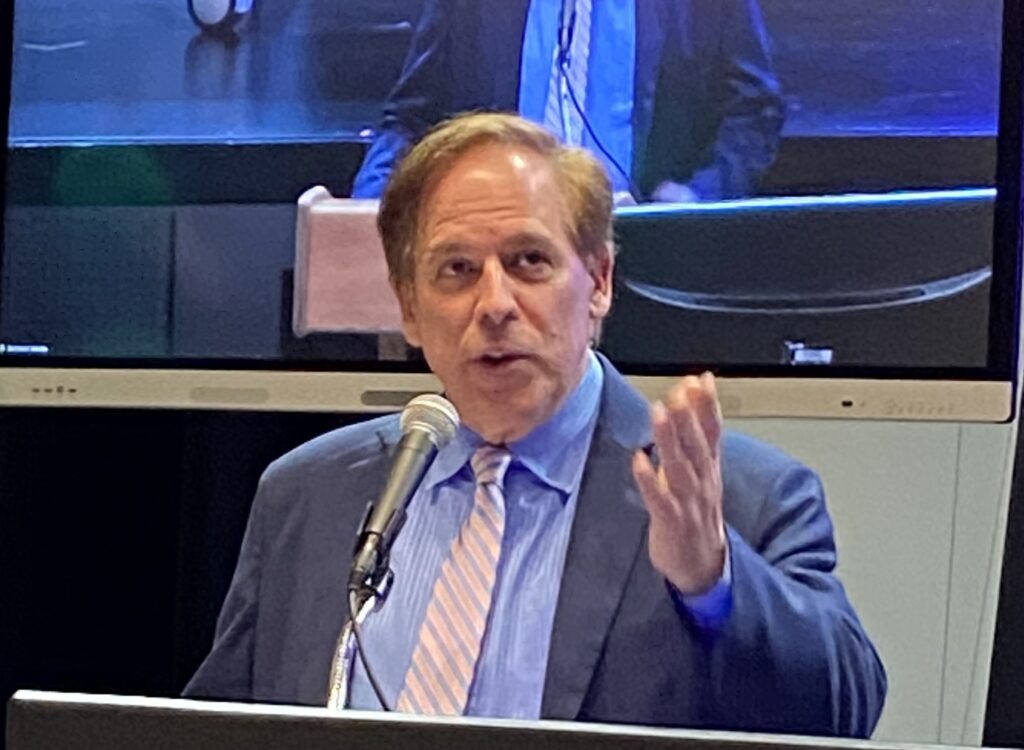
That being said, Rogers said his year’s House Budget has increased Chapter 70 funding for K-12 received a 5.6 percent increase via the new “millionaires” surtax passed by voters last year. He also highlighted his efforts to increase funding for immigrant legal defense to hire attorneys to represent those in deportation proceedings, including “some whose due process rights may not be being observed.”
Rogers said he tries to find a few bucks in the budget to direct to the town. “While I can’t get a ton of money, I fight for earmarks for Belmont,” Rogers said. These include:
- $75,000 for renovations – adding a fifth court – to the Winn Brook tennis courts.
- $75,000 to expand the town’s tree canopy.
There were also two earmarks from the state’s supplement budget – that’s the millionaire’s surtax – including:
- $75,000 for sidewalk safety improvements.
- $100,000 towards the Chenery Park revitalization.
Warrant Committee Chair Paul Rickter gave a standard overview of the fiscal ’26 budget, including how the $166.2 million budget is segmented (education receives 43 percent or $70.9 million) and some historical context, such as the fact that exempted debt has increased by 247 percent in the past 12 years, from $4.8 million to $16.6 million.
But what Rickter stressed in his report was the importance of the “revenue-first balanced budget” process, first used by town and school budget writers for the fiscal ’25 budget, a development he and the committee were “overjoyed” to see being used as it created a disciplined approach to the process.
“Keep doing it,” advised Rickter.
The projects
The CPC approved and sent to the Town Meeting a request for $650,000 allocated to Belmont Village, one of Belmont’s three public housing projects. The funds will go to complete the conceptual design for the revitalization of the nearly 70-year-old development, with the opportunity to double the number of units to 200 apartments on the 6.6-acre site. In 2020, the Town Meeting approved $173,000 in an initial request.
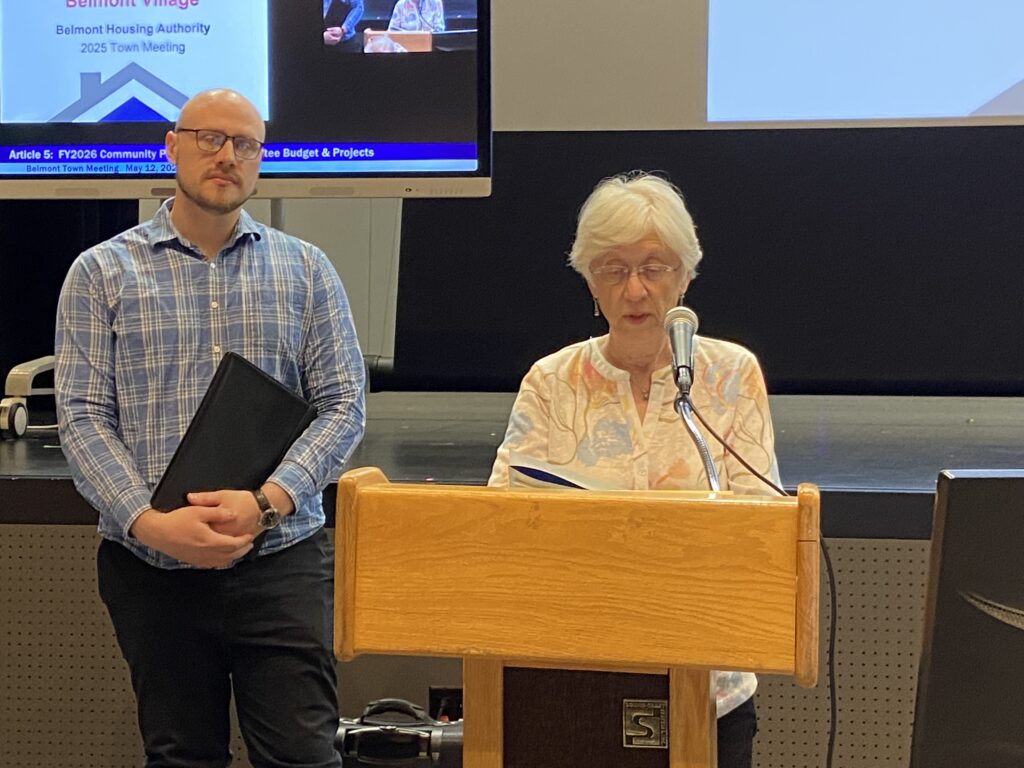
With the funding, site planning work will kick off in the summer with a study draft by the end of the year. An additional $1.2 million will then be needed for final architectural and engineering plans, consultants’ fees, and extra costs to finish the pre-development phase.
Gloria Leipzig, chair of the Belmont Housing Trust, which sponsored the measure, told the members that their support for the redevelopment efforts at Belmont Village and Sherman Gardens “will provide housing for our residents, seniors, those with disabilities, and families. And very importantly, we’ll also create additional and much-needed affordable housing here in Belmont.”
Matt Zajac of the Cambridge Housing Authority—which has partnered with Belmont as a co-developer of the Belmont Housing Authority’s sites since 2021 —said that after the study is completed, the BHA/CHA can begin to leverage state and federal financing sources. He said that it will take three, five, or ten years before construction will take place.
During the questions, members asked about spending funds on a project in which millions of dollars in funding will be required to upgrade units and construct new structures that have not been secured. “Is there any visibility for funding sources to carry out these plans? Otherwise, this is income transfer to white-collar professionals, not improvements in the affordable housing conditions,” asked Liz Allison (Precinct 3). Zajac replied that the most likely potential funding source will be the Low-Income Housing Tax Credit Program.
Some members were disappointed that the CPC wasn’t banking the funding remaining in this year’s housing “bucket” for future housing requests. Angus Abercrombie, Precinct 8, said he would vote against the other CPC measures—despite being in favor of their approval—as a symbolic protest against the town’s inaction.
The measure passed 222-6-3.
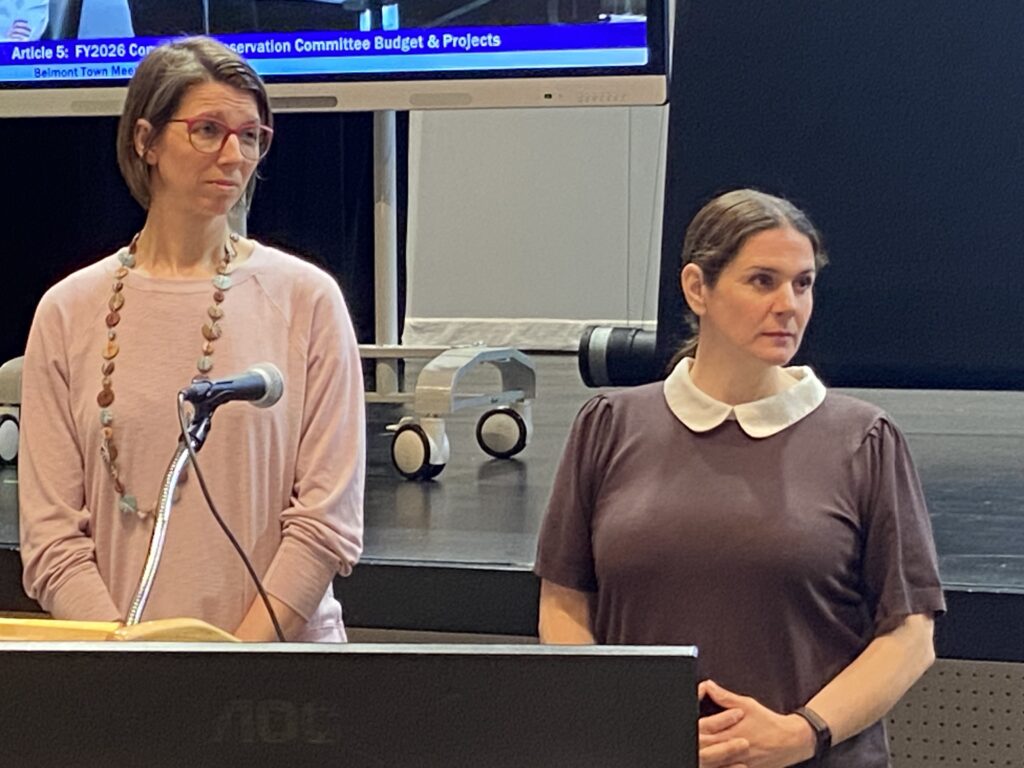
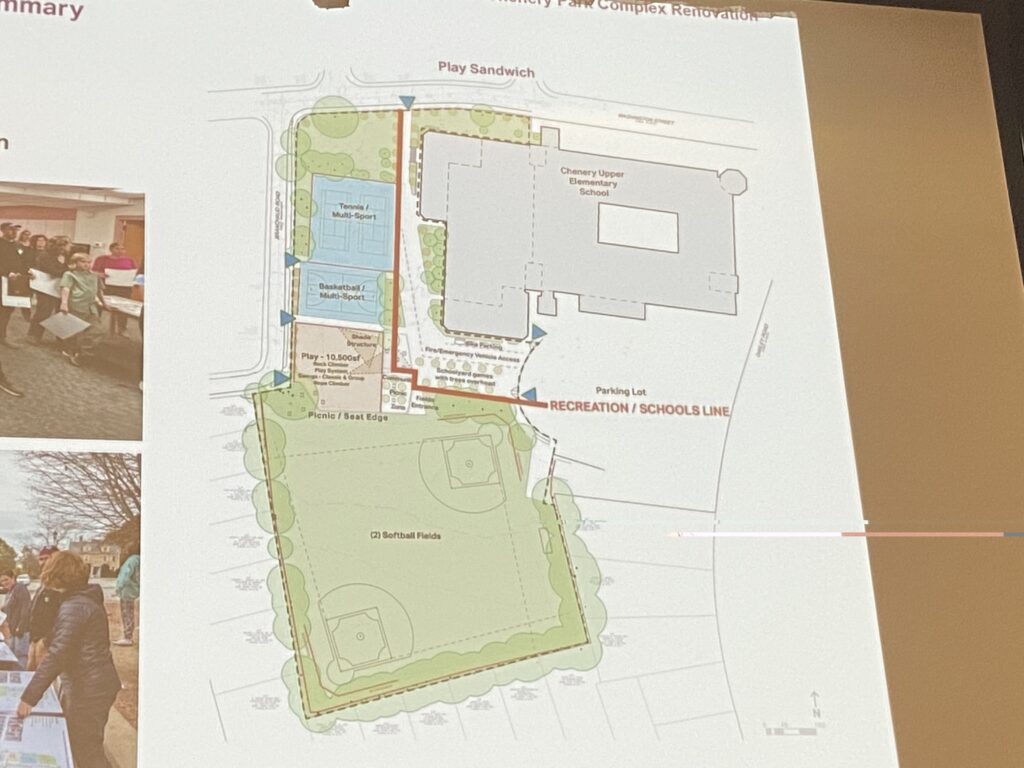
The biggest ticket item before members Monday was $2 million—$200,000 from the CPA and $1.8 million from the undesignated fund balance—to renovate the dilapidated Chenery Upper Middle School grounds and play area. This request came on top of a $1 million CPC request approved by the Town Meeting last year for construction costs and $300,000 for the project’s design and engineering.
Laura Burnes and Nicole O’Connell, the co-chairs of the Friends of Chenery Park, said the groundwork for this application to redo the nearly quarter-century-old field and playground with outreach to the community, sports leagues, and the town to develop an overview of the project. When the first chunk of funding was received in 2024, the Friends began holding community engagement events to collect data and comments on what the public wanted to see in the project.
On Monday, the Friends presented a final design dubbed the Play Sandwich, in which sports programming is the “bread” and the play area is the “middle” filling. “We’ve got lots of multi-sports use … tennis as well as street hockey and soccer and basketball, but the space can also accommodate volleyball and badminton,” said O’Connell. The main field holds two renovated softball diamonds.
While the request totals a whopping $3.3 million, the project had broad support. Many members said visiting the site would convince those initially skeptical to support the measure. Just as crucial to its passage was Burnes and O’Connell’s well-planned public participation blueprint, which allowed the wider community to enthusiastically buy in on the project. Future large projects would be wise to use the Friends playbook as a template for a successful campaign.
The Chenery playground renovation – which begins this summer – passed 222-5-1.
Facilities Director Dave Blazon says the Homer Building restoration will allocate $550,396 to repair and replace deteriorating architectural elements. The bill passed 222-7-6.
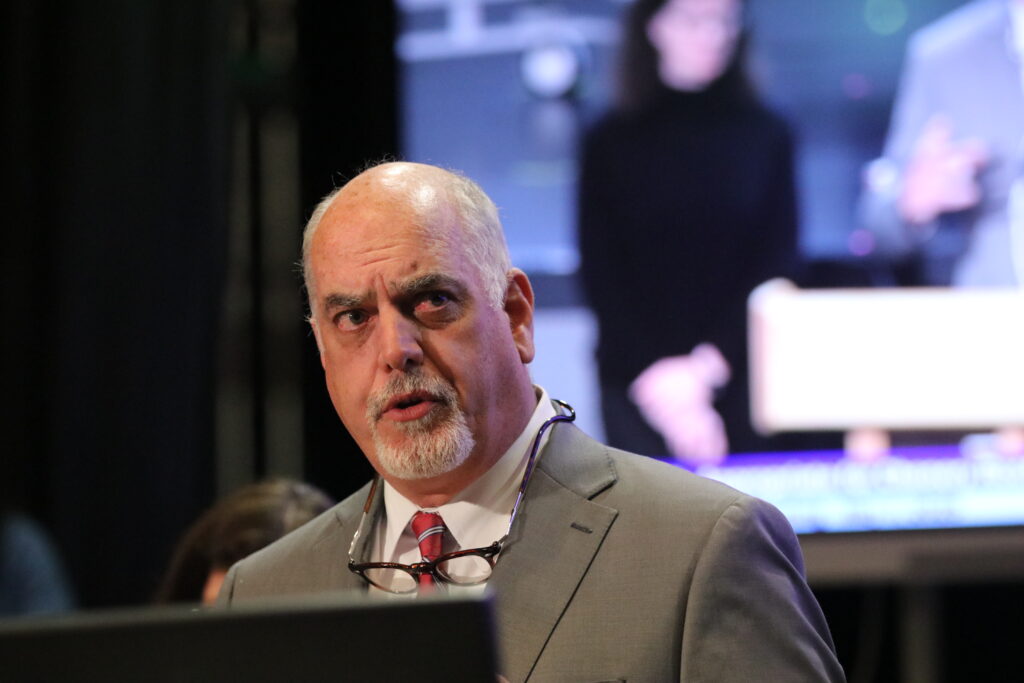
Restoring the failed Town Hall retaining wall so the ramp and stairs on the Concord Avenue entrance don’t collapse, said Blazon. Members, by a 231-6-4 margin, thought spending $850,000 for the job was a good thing.
The commissioning of a design to completely restore the “Burial Hill” area of Belmont Cemetery got out of the CPC by a single vote, 4-3-1, which usually spells trouble for a measure. However, the request was initiated by resident Ron Sacco, who told DPW Director Jay Marcotte this past August of his difficulty finding an ancestor’s grave in the northeast corner of Belmont Cemetery, which holds its oldest internments. Upon inspection, the steep incline was overgrown and deteriorating, making identifying the exact locations of graves impossible.
When Sacco asked the DPW if it could “start digging,” Marcotte said he had a better plan and approached a consultant. A design plan focusing on headstone repairs and restoration, searching for missing headstones, erosion control, and vegetation options would cost $60,000. This would be followed by a CPC request in 2026 for the still-to-be-determined cost of the construction.
What closed the deal was that Sacco’s relative is buried among veterans. When a member didn’t believe the request was “a wise use of funds because somebody can’t find this relative” as it would “[set] a precedent which is not good,” Ann Marie Mahoney (Precinct 1) rose to say “as the daughter, spouse and mother of veterans, we owe these people no matter how many hundreds of years ago they were down for we owe them the restoration and the appropriate care.”
“It’s also for the respect for everyone that made a commitment and the expectation that they will be taken care of basicallyforever. And it’s just respect for the dead and to care for those that entrusted us to take care of the burial site forever,” said Mahoney.
The measure passed 218-10-8.
The issue with the Clay Pit Pond Walking Path is that while nearly 2/3 of the trail has been completed, the remaining path clashes with an established asphalt lane bordering Belmont Middle and High School. The town didn’t believe the Town Meeting would approve the Conservation Commission’s request to seek a parallel footpath. For allowing the town to remove the request, the town is proposing to an request seeking a parallel footpath. For allowing the town to remove the request, the town is proposing to allocate an equivilant amount towards improvements at Rock Meadow Conservation Land.